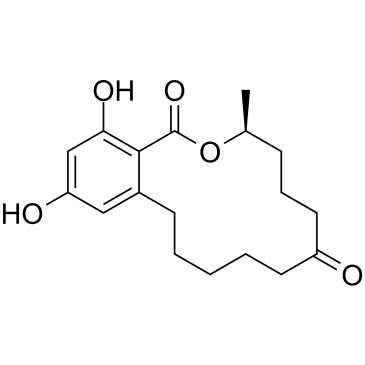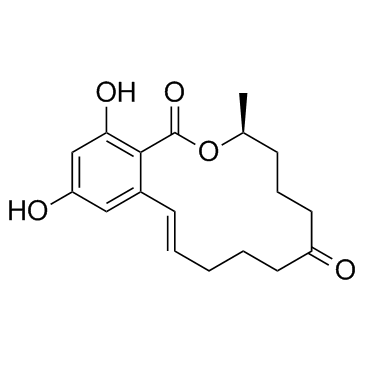Zearalanone

Zearalanone structure
|
Common Name | Zearalanone | ||
|---|---|---|---|---|
| CAS Number | 5975-78-0 | Molecular Weight | 320.380 | |
| Density | 1.1±0.1 g/cm3 | Boiling Point | 576.8±50.0 °C at 760 mmHg | |
| Molecular Formula | C18H24O5 | Melting Point | 184-186ºC | |
| MSDS | Chinese USA | Flash Point | 209.2±23.6 °C | |
| Symbol |


GHS07, GHS08 |
Signal Word | Warning | |
Use of ZearalanoneZearalenone is a nonsteroidal estrogenic mycotoxin produced by Fusarium species, which colonizes several grains. Zearalenone has low acute toxicity and carcinogenicity. Due to its agonistic effect on the estrogen receptor, Zearalenone exhibits distinct estrogenic and anabolic properties in several animal species, resulting in severe effects on the reproductive system[1]. |
| Name | (S)-Zearalanone |
|---|---|
| Synonym | More Synonyms |
| Description | Zearalenone is a nonsteroidal estrogenic mycotoxin produced by Fusarium species, which colonizes several grains. Zearalenone has low acute toxicity and carcinogenicity. Due to its agonistic effect on the estrogen receptor, Zearalenone exhibits distinct estrogenic and anabolic properties in several animal species, resulting in severe effects on the reproductive system[1]. |
|---|---|
| Related Catalog | |
| Target |
Estrogen receptor |
| References |
| Density | 1.1±0.1 g/cm3 |
|---|---|
| Boiling Point | 576.8±50.0 °C at 760 mmHg |
| Melting Point | 184-186ºC |
| Molecular Formula | C18H24O5 |
| Molecular Weight | 320.380 |
| Flash Point | 209.2±23.6 °C |
| Exact Mass | 320.162384 |
| PSA | 83.83000 |
| LogP | 3.45 |
| Vapour Pressure | 0.0±1.7 mmHg at 25°C |
| Index of Refraction | 1.526 |
| Storage condition | −20°C |
| Symbol |


GHS07, GHS08 |
|---|---|
| Signal Word | Warning |
| Hazard Statements | H302-H312-H315-H319-H332-H335-H351 |
| Precautionary Statements | P261-P280-P305 + P351 + P338 |
| Personal Protective Equipment | Eyeshields;full-face particle respirator type N100 (US);Gloves;respirator cartridge type N100 (US);type P1 (EN143) respirator filter;type P3 (EN 143) respirator cartridges |
| Hazard Codes | Xn |
| Risk Phrases | 20/21/22-36/37/38-40 |
| Safety Phrases | 22-26-36 |
| RIDADR | UN 1648 3 / PGII |
| WGK Germany | 3 |
| HS Code | 29322090 |
|
~19% 
Zearalanone CAS#:5975-78-0 |
| Literature: El-Sharkawy, Saleh H.; Abul-Hajj, Yusuf J. Journal of Organic Chemistry, 1988 , vol. 53, # 3 p. 515 - 519 |
| Precursor 1 | |
|---|---|
| DownStream 0 | |
|
Preliminary estimation of deoxynivalenol excretion through a 24 h pilot study.
Toxins (Basel.) 7 , 705-18, (2015) A duplicate diet study was designed to explore the occurrence of 15 Fusarium mycotoxins in the 24 h-diet consumed by one volunteer as well as the levels of mycotoxins in his 24 h-collected urine. The ... |
|
|
Development of a multi-toxin method for investigating the carryover of zearalenone, deoxynivalenol and their metabolites into milk of dairy cows.
Food Addit. Contam. Part A. Chem. Anal. Control. Expo. Risk Assess. 32(3) , 371-80, (2015) A dose-response study was carried out to examine the carryover of zearalenone (ZEN), deoxynivalenol (DON) and their metabolites into bovine milk. Therefore, a feeding trial with 30 dairy cows fed with... |
|
|
Development and validation of an UHPLC-MS/MS method for the determination of mycotoxins in grass silages.
Food Addit. Contam. Part A. Chem. Anal. Control. Expo. Risk Assess. 32 , 2101-12, (2015) An ultra-high-performance liquid chromatography-tandem mass spectrometry (UHPLC-MS/MS) multi-mycotoxin analytical method was developed to simultaneously identify and quantify 20 mycotoxins in grass si... |
| Zearalanone |
| 1H-2-Benzoxacyclotetradecin-1,7(8H)-dione, 3,4,5,6,9,10,11,12-octahydro-14,16-dihydroxy-3-methyl-, (3S)- |
| (11S)-15,17-dihydroxy-11-methyl-12-oxabicyclo[12.4.0]octadeca-1(18),14,16-triene-7,13-dione |
| (3S)-14,16-Dihydroxy-3-methyl-3,4,5,6,9,10,11,12-octahydro-1H-2-benzoxacyclotetradecine-1,7(8H)-dione |
